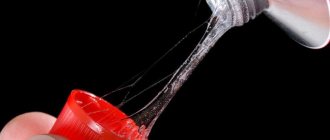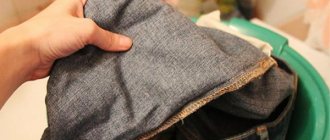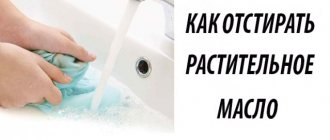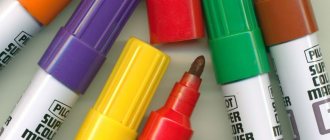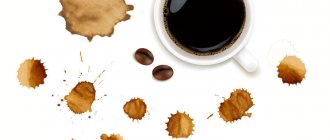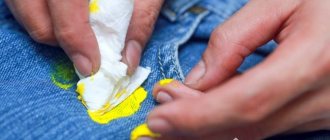Paint that gets on fabric is a complex type of contamination that can be difficult to deal with at home.
However, if you take action in time and use the right tools, you can return things to their original appearance.
Housewives get rid of stains using vinegar, kefir, ammonia and even butter. If results cannot be achieved, then they resort to household chemicals.
Let's take a closer look at how to remove dried paint from clothes at home.
Things to consider
- If the item is expensive and you are afraid to take risks, it is better to immediately take it to the dry cleaner.
- If you want to clean the dirt yourself, don’t delay it. Try to scrub off the paint within the next few hours after the stain appears.
- If the paint has had time to dry thoroughly, first very carefully scrape off the top layer with a blade. This will make it easier to wash it off. But if the fabric is quite delicate, it is better not to use a blade, otherwise you may accidentally tear it.
- All the methods below are working. They have been tested by real people who have shared their experiences on various forums. But very often it is not clear what kind of paint left the mark. Therefore, if the product does not help, perhaps it is simply not suitable for the substance in which your item is stained.
- If the stain is large, you can try several products on it at once in different areas. This way you will know which method will definitely help you. If the stain is small and the chosen product cannot cope with it, just try another one, lightly rinsing off the previous one with water.
- Also test the selected product first on an inconspicuous area of clothing. This will ensure that the color of the fabric is not affected.
- You can rub the product into a rough cloth with any brush or the back of a dishwashing sponge. For delicate stains, it is better to rub it with your hands or clean the stain with the fabric itself, as when washing.
Can I remove it myself?
You can remove paint stains from clothes if you do it correctly.
The complexity of the work is due to a number of factors, including:
Duration of stay of the stain on clothing. The faster measures are taken to remove it, the easier it is to deal with the stain.- Type of dye. The hardest thing is to get rid of persistent compounds (hair and eyelash dye, construction paints). Art and food dyes are easier to remove.
- Degree of pollution. The larger the stain, the more difficult the work to remove it.
The type of matter matters. Paint penetrates faster and deeper into fibrous fabrics than into a smooth surface. The task becomes more difficult if the stain was applied to delicate fabrics.
When can you handle it yourself, and when should you turn to professionals for help?
Before you begin processing, you need to pay attention to the following points:
- It is almost impossible to get rid of construction paints (water-based, acrylic, oil) on your own. Sometimes it is not possible to remove them even in professional dry cleaners.
- The best stains to remove are from thick fabrics, such as jeans.
- You can deal with the stain yourself if no more than 2-3 days have passed since the paint got on your clothes. Later, it will be difficult to remove it at home.
If even the professionals couldn’t get rid of the paint, but you want to preserve the item, you can use decorative techniques. Stains are masked with rhinestones, stickers, stripes and other elements.
How to deal with paint marks on clothes
There are several basic rules regarding stain removal:
- It is necessary to act quickly, since dried and old blots are much more difficult to remove than fresh ones.
- You should choose a suitable remedy. Blind use of solvent can damage the fabric and ruin the item forever. Before removing a stain, it is necessary to determine the type of material and dye.
- Before removing traces of paint from clothing with a certain product, you should test it on a small area of the fabric. If the fibers do not break, the color does not fade and the texture of the material remains the same, then the product can be safely used on the entire product.
- Stains are processed from the inside out. Household chemicals and solutions according to folk recipes should be applied to the back of the product.
- After the procedure, the clothes are washed to remove the stain. Preference is given to detergents in the form of a gel.
Important! Before processing, you must read the product label, which states the composition of the material and washing rules. You should not neglect them, so as not to spoil the thing.
Traditional methods
In some cases, it is not necessary to immediately use aggressive chemicals - you can solve the problem using folk recipes.
Gasoline and alcohol
Gasoline is good for removing stains from oil paints. You need to apply it to a cotton swab and rub the stain all around. After the procedure, the item is washed using powder or gel.
Attention! It is necessary to purchase only refined gasoline, which is sold in hardware stores. A regular product may stain clothing due to impurities in the composition.
Another effective remedy is a combination of laundry soap and alcohol. This recipe can be used against difficult stains on silk and satin. First, the blot is rubbed with soap, then the fabric is rinsed, and the contaminated area is treated with alcohol. Before this, the liquid must be heated in a water bath. After cleaning, you must hand wash the item in hot water.
Alcohol and salt help remove paint from both linen and nylon fabric. The blot needs to be rubbed with heated alcohol on the reverse side, then prepared with a saline solution and washed off any remaining dirt.
Hair fixation spray
Many hair styling products contain weak solvents. They do not harm human health, but help remove stains. Just spray the varnish and throw the item in the wash.
Salt and vinegar
To clean clothes from acrylic dye, you need to prepare a solution from the following ingredients:
- salt – 1 tbsp. l.;
- ammonia - 2 tbsp. l.;
- vinegar - 2 tbsp. l.;
- water – 750 ml.
The components need to be mixed and poured into the blot, leaving the product in the basin overnight. It is recommended to cover it so that the smell of ammonia does not spread to other rooms. The procedure is repeated until the dye completely disappears.
Acetone
Instead of acetone, nail liquid is suitable. First you need to soak a cotton swab in the solution, then start rubbing the stain from the edge to the middle. At the end of the procedure, the item is thrown into the machine.
Attention! Acetone is not used on delicate fabrics.
Turpentine
This product is suitable for removing stains from delicate materials such as silk, satin and wool.
First, apply a little turpentine to a cotton swab to treat the blot on the front and back of the fabric. After 10 minutes, cover the stain with paper towels on both sides and press together with your palms. There will be traces of paint on the paper that were removed by the product.
After this, the dirt is wiped off again with turpentine and left for 60 minutes, then the clothes are washed in the usual way in a machine or by hand.
Glass cleaner
To remove stains from clothes, just spray glass cleaner and rub it in for 2-3 minutes. After this, the dirt is rinsed off and the cleaning is repeated again.
Paint stains are not a death sentence for things, since they can be removed with folk remedies and household chemicals. Before the procedure, you must wear protective gloves and follow safety precautions. If the fabric is expensive and requires special care, then it is recommended to take the clothes to the dry cleaner rather than clean them yourself.
5/5 — (1 vote)
Removing other stains
It is not uncommon to need to clean other types of paint. It is worth considering separately for children: gouache and watercolor. They are water-based, so fresh stains can be removed with regular washing. Large stains may not be washed off completely, leaving their mark on the entire surface of the clothing. Such contaminants are first washed by hand under waste water, after which they are also sent to the washing machine.
Enamel products are susceptible to solvents. Soak a cotton pad in it, squeeze out the excess and start wiping off the dye. As the color changes to the cotton wool, replace it with a new one.
The easiest way to deal with stains on leather products. Very fresh marks can be wiped off with regular wet wipes. More complex ones with vegetable oil or laundry soap. Rub the selected product onto the stain, wipe with a dry soft cloth and remove any residue with a damp, clean cloth.
Delicate fabrics require a unique approach. Heat ammonia to a temperature of 40-50 degrees, lightly moisten a cotton swab and wipe gently. Replace the tampon as needed and continue cleaning until completely clean. Finally, pour warm water into the basin, add enough salt to form a weak saline solution. Rinse the item in it.
If it is difficult to determine the type of paint, use a universal laundry soap. Rub the contaminated surface thoroughly and leave for 1-2 hours. Wipe with cotton and rinse.
How to properly wash children's clothes
As I already wrote above, children's clothes are much more delicate in fabric than adults. In addition, babies' skin is much more sensitive to the clothes they wear.
Therefore, washing children's clothes requires careful and careful care. To wash children's clothes and remove watercolor paints from them, choose the following products:
- choose baby powders, for example, “Eared Nanny”, “Stork”.
- Laundry soap will help out in almost any situation. Rub it onto the stain on children's clothing, let it soak in a little and wash the item. There will be no traces left of the watercolor!
- If you don't have laundry soap, you can use simple baby soap. As a rule, it contains hypoallergenic substances that are safe for children’s skin, and therefore their clothes.
- Bleach and products with complex chemical compositions should not be used.
Type of fabric and methods of removing stains: selection of the optimal option
Depending on the type of fabric, the method for removing stains is selected. After using any of the products, wash the clothes as usual.
| Fabric type | Approach to removing stains |
| Cotton (including denim) and Linen | Cotton fabric allows you to use a variety of methods to remove watercolor stains. One of the most effective is based on laundry soap and soda, the other is using hydrogen peroxide. |
| Carpet or upholstery | Special shampoos intended for cleaning carpets; if they are not available, liquid soap whipped with water into foam |
| Synthetics | Wiping the surface of the stain with ammonia and rinsing clothes in salted water |
| Natural silk, wool | Treat with a solution of laundry soap where the paint gets in contact, leave to dry and rinse in water. |
Adviсe
Recommendations for removing dried paint:
Paint-stained items should be washed separately from other clothes.- To increase washing efficiency, the fabric needs to be soaked.
- When working with aggressive agents, gloves should be used.
- You need to wash the stain as quickly as possible, even if it has already dried.
- To get rid of gouache and watercolor paints, regular washing using a simple powder is enough.
If paint is removed from fabric with cotton wool, it should be changed as often as possible so as not to smear the pigment onto clean fibers.
Latex and acrylic paints
Latex and acrylic paint are easy to wash off while the stain is fresh. Clothes with such stains are soaked in a cold solution of laundry soap. If the stains are difficult to clean, the items are loaded into the washing machine and a long wash cycle is started at a temperature of 30 ℃.
Dried paint can be scrubbed off with a brush using powder or a paste of water and soap shavings. You can use stain removers suitable for the fabric. In the most difficult cases, they resort to solvents: white spirit or purified gasoline.
Gasoline, kerosene, acetone and white spirit are the “heavy artillery”. Use these remedies only in cases where other options have not worked. Remember that there is a very high risk of ruining the fabric.



